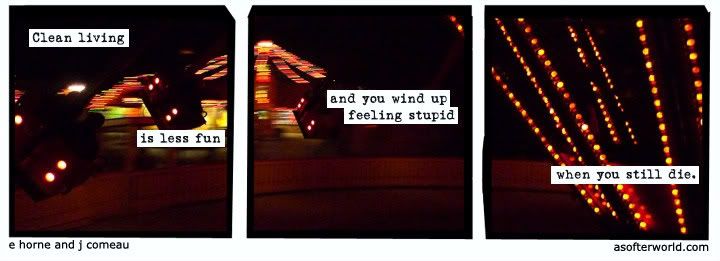
This writing project takes another common form of communication in the world today of cartoons and comic strips. The comic strip that I have chosen is a selection from the “A Softer World” collection. It is called “I’ve been waiting” and was put together by Emily Horne and Joey Comeau. This comic contains several elements that I want to discuss that develop the argument of the photograph through logos.
The most important aspect of this comic is the relationship between the photograph that comprises the background of each three panels and the words that appear throughout them. This relationship is developed in a chronological progression because of the fact that the entire comic is the photograph that itself is just of one moment in time. This is also provided by the motion seen in the photograph that relates to the progression of time referred to in the words. In the words themselves is the aspect of word play that matches up with what is depicted in the photo. The arrangement of the words throughout the comic also develops logos because of the effect it has on the reader to read each statement and process it and then move on to the next panel. I also want to discuss the meaning of the words themselves and how the tone and specific word choice are also forms of logos working in this comic.
This writing project would be very hard to do without the comic that I am discussing being able to be viewed by the reader of my writing. This is made possible through the context in which I am writing which is a blog. The internet helps this tremendously due to the fact that I can post hyperlinks that will lead the reader to information that can further my statements without explanation that may not be exactly pertinent to the writing. Also, I can include other images that will literally illustrate an aspect of the comic I am referring to or to just provide more visual aid to the reader.
The reader of my writing project will primarily be the teacher of the course, even though I am not directly addressing him obviously. I will be working to fulfill the expectations of this writing project that include a word count minimum and maximum, number of provided hyperlinks and multimedia elements, and other technical aspects. I will also be working to fulfill the need of the writing project in terms of actually creating something that accurately communicates what I wish to and that the 151H course requires. Secondary audiences include other members of my 151H course now and those who have previously taken it. Also, because my post is on the Internet, my blog is open for anyone to read that happens upon it. I wish to best communicate to all of these audiences.
This writing project has taken me farther into the world of rhetorical analysis through the analysis of comics, which I have not looked at in the same way as is necessary for this project. I aim to best communicate the argument that I have found that the comic makes through the aspect of logos that is most importantly ascribed in the relationship of the words and photograph that are the comic.

